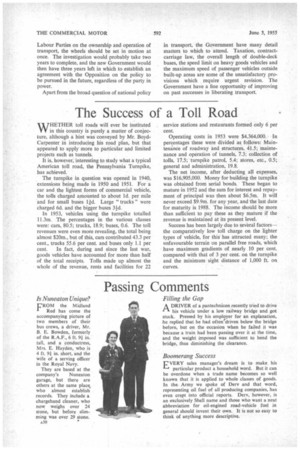The Success of a Toll Road
Page 32

If you've noticed an error in this article please click here to report it so we can fix it.
WHETHER toll roads will ever be instituted in this country is purely a matter of conjecture, although a hint was conveyed by Mr. BoydCarpenter in introducing his road plan, but that appeared to apply more to particular and limited projects such as tunnels.
It is, however, interesting to study what a typical American toll road, the Pennsylvania Turnpike, has achieved.
The turnpike in question was opened in 1940. extensions being made in 1950 and 1951. For a car and the lightest forms of commercial vehicle. the tolls charged amounted to about lid. per mile and for small buses lid. Large " trucks " were charged 6d. and the bigger buses 31d.
In 1953, vehicles using the turnpike totalled 11.3m. The percentages in the various classes were: cars, 80.5; trucks, 18.9; buses, 0.6. The toll revenues were even more revealing, the total being almost $20m., but of this, cars contributed 43.3 per cent., trucks 55.6 per cent. and buses only 1.1 per cent. In fact, during and since the last war, goods vehicles have accounted for more than half of the total receipts. Tolls made up almost the whole of the revenue, rents and facilities for 22 service stations and restaurants formed only 6 per cent.
Operating costs in 1953 were $4,364,000. In percentages these were divided as follows: Maintenance of roadway and structures. 41.5; maintenance and operation of tunnels, 7.3; collection of tolls, 17.5; turnpike patrol, 5.4; stores, etc., 0.5; general and administration, 19.8.
The net income, after deducting all expenses, was $16,905,000_ Money for building the turnpike was obtained from serial bonds. These began to mature in 1952 and the sum for interest and repayment of principal was then about $6.5m. It will never exceed $9.9m. for any year, and the last date for maturity is 1988. The income should be more than sufficient to pay these as they mature if the revenue is maintained at its present level.
Success has been largely due to several factors— the comparatively low toll charge on the lighter types of vehicle, for this has attracted many; the unfavourable terrain on parallel free roads, which have maximum gradients of nearly 10 per cent. compared with that of 3 per cent. on the turnpike and the minimum sight distance of 1,000 ft. on curves.




































































































